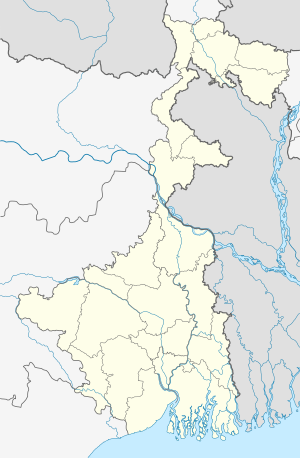Pattabong Tea Garden
Pattabong Tea Garden (also spelled Puttabong) is a village in the Darjeeling Pulbazar CD block in the Darjeeling Sadar subdivision of the Darjeeling district in the state of West Bengal, India.
Pattabong Tea Garden Puttabong (Tukvar) Tea Estate | |
|---|---|
Village | |
 Pattabong Tea Garden Location in West Bengal, India  Pattabong Tea Garden Pattabong Tea Garden (India) | |
| Coordinates: 27.06762°N 88.25951°E | |
| Country | |
| State | West Bengal |
| District | Darjeeling |
| Population (2011) | |
| • Total | 1,633 |
| Languages | |
| • Official | Nepali, English |
| Time zone | UTC+5:30 (IST) |
| Vehicle registration | WB |
| Website | wb |
Geography
Tea estate
Puttabong Tea Estate is one the largest tea gardens in Darjeeling with an area under tea plantation of 4.37 km2 (2 sq mi) while the gross area is 8.92 km2 (3 sq mi).[1][2]
Area overview
The map alongside shows the northern portion of the Darjeeling Himalayan hill region. Kangchenjunga, which rises with an elevation of 8,586 metres (28,169 ft) is located further north of the area shown.[3]Sandakphu, rising to a height of 3,665 metres (12,024 ft), on the Singalila Ridge, is the highest point in West Bengal.[4]In Darjeeling Sadar subdivision 61% of the total population lives in the rural areas and 39% of the population lives in the urban areas.[5][6]There are 78 tea gardens/ estates (the figure varies slightly according to different sources), producing and largely exporting Darjeeling tea in the district. It engages a large proportion of the population directly/ indirectly.[7]Some tea gardens were identified in the 2011 census as census towns or villages. [8]Such places are marked in the map as CT (census town) or R (rural/ urban centre). Specific tea estate pages are marked TE.
Note: The map alongside presents some of the notable locations in the subdivision. All places marked in the map are linked in the larger full screen map.
Demographics
According to the 2011 Census of India, Pattabong Tea Garden had a total population of 2,347 of which 1,137 (48%) were males and 1,210 (52%) were females. There were 153 persons in the age range of 0 to 6 years. The total number of literate people in Pattagong Tea Garden was 2,012 (85.73% of the population over 6 years).[9]
As of 2001 India census,[10] Puttabong Tea Estate had a population of 1633. Males constituted 49% of the population and females 51%. Puttabong Tea Estate has an average literacy rate of 75%, higher than the national average of 59.5%: male literacy is 84%, and female literacy is 66%. In Puttabong Tea Estate, 8% of the population is under 6 years of age.
Notable persons
Phiroj Shyangden. Songwriter, singer, guitarist, composer. Former founding member of 1974 AD and The Original Duo.
References
- "Tukvar (Puttabong) Tea Estate, Darjeeling". Visit North East. Retrieved 8 March 2020.
- "Tukvar (Puttabong)". Jay Shree Tea & Industries Ltd. Retrieved 8 March 2020.
- Gurung, H. & Shrestha, R. K. (1994). Nepal Himalaya Inventory. Kathmandu: Ministry of Tourism and Civil Aviation.
- "Sandakphu-Phalut Trek". Himalayan High. Retrieved 21 March 2020.
- "Darjeeling". District Profile - General Information. District administration. Retrieved 21 March 2020.
- "District Statistical Handbook 2013 Darjeeling". Tables 2.2, 2.4b. Department of Planning and Statistics, Government of West Bengal. Archived from the original on 21 January 2019. Retrieved 21 March 2020.
- "Darjeeling Tea". District administration. Retrieved 21 March 2020.
- "2011 Census – Primary Census Abstract Data Tables". West Bengal – District-wise. Registrar General and Census Commissioner, India. Retrieved 21 March 2020.
- "2011 Census – Primary Census Abstract Data Tables". West Bengal – District-wise. Registrar General and Census Commissioner, India. Retrieved 10 March 2020.
- "Census of India 2001: Data from the 2001 Census, including cities, villages and towns (Provisional)". Census Commission of India. Archived from the original on 16 June 2004. Retrieved 1 November 2008.